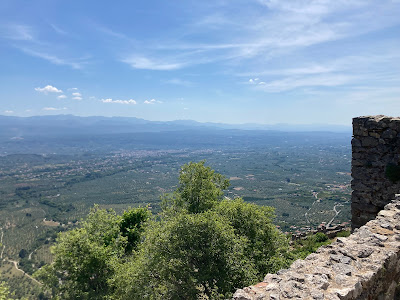The history of the Citadel and walled city of Mystras begins during the Frankish Conquest of Greece following the Fourth Crusade (1204 A.D.) when William II of Villehardouin, who ruled the Frankish principality of Achaea. Having just completed his conquest of Laconia in 1248 A.D., he chose a spur of Mt. Tagyetos - long famous in ancient literature as towering above Sparta - to build a fortress to control the region.
William was captured by Byzantine forces in 1259 A.D.; in 1262 A.D. the fortress was returned to the Byzantines. It was expanded and became the governmental seat of the Morea. Initially it served as a major fortress in the ongoing struggle between the Byzantines and the Franks. It continued to grow in importance until in 1349 A.D. it was declared a royal capital and the seat of the Despotate of the Morea. It survived the fall of Constantinople ibut was surrendered to the Ottoman Turks in 1460 A.D., the last major Byzantine territory in the Greek Peninsula (in an interesting historical footnote, it fell on the same day as Constantinople did, 9 years later). Other than being occupied by the Venetians briefly in the late 16th - early 17th century, it remained in Ottoman hands until 1823, when the local population was destroyed in the Greek War for Independence. A few families moved to the small town of Mystras at the foot of the mountain.
The city remains a unique archaeological site, a very well preserved walled city with many of its buildings intact - if you want to think about it such (I did), a sort of "What would Minas Tirith look like and be like in real life?" Short answer: Lots and lots of uneven stairs and climbing.
Today's views are all taken from the citadel. Next post we will visit the rest of the city.














Very interesting looking place. Different from the other sites you've shown us, but I suppose it's because of the later dates and influences of the Byzantines and Franks. I know nothing of history in that part of the world. I don't suppose there'd ever be enough time to study it all.
ReplyDeleteLeigh, one of the really nice things about this tour was the fact that we got to get exposed to so many different periods of history and their architecture.
DeleteThere is indeed more history than any of us have time to study. But I keep trying!
Odd, started reading Morea as Moria. Yah, I know,,,, above ground mountain top fortress and underground complex. Too much heat lately.
ReplyDeleteThe names are quite close, Nylon12, although I have never heard that Morea was the origin of the name Moria in Tolkien's works.
DeleteVery interesting photos.
ReplyDeleteAnd good history, too.
Thank you, TB.
You all be safe and God bless.
You are welcome, Linda. It is one of the points of history that for most of us in the US, probably gets a single sentence or maybe two and that is it.
Delete